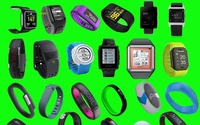 Wearable
computing is going more mass market.
Wearable
computing is going more mass market.
We’re not talking just about smart watches or fitness trackers, but actual clothing that’s being made ‘smart,’ thanks to embedded
technologies.
Like fitness trackers, smart clothing generally needs a companion mobile app so the wearer can receive information captured by the smart thing being worn.
One latest
example of smart clothing is the Ralph Lauren polo shirt that can transmit workout information to a smartphone.
But wearables can be a range of things, including sensor-infused devices,
clothing that reads biometric data off a body, a body mounted camera or smart glasses.
The most frequently seen are fitness trackers and smart watches, but wearables can be worn on the wrist,
back, chest, head, foot or clothing.
Driven largely by smart watches, the wearables market will grow from 18 million shipments two years ago to 197 million within five years, according to the
research firm Tractica.
By 2020, smart watches will be the lead wearables category, accounting for 48% of total shipments, followed by fitness trackers with 45 million units shipped, according
to the report.
But the ultimate wearable computer is a piece of smart clothing that can be worn as a garment, according to Tractica.
Marketing efforts to date have focused around
device features, the look and feel and design in creating fitness products while lacking an explanation of the actual consumer value, according to the report.
Coming next is the messaging. The
true value in wearables can come from extracting useful data from the devices and generating actionable insights, or with the software filtering contextual information and presenting it to the
device.
The ultimate success of wearables will be in the services provided. Companies like Fitbit and Jawbone have created feature-rich member services with highly personalized messaging,
which is a start.
But the play for brands and even retailers goes beyond that.
A BMW app could alert users when their wearable data suggests they are too tired to drive, a Walmart app
could recommend groceries based on activity and diet plan or Google Maps could suggest a route to work that includes the optimum amount of walking, as examples cited in the report.
The value
will not be in the actual device but rather in the messaging that brands and marketers can create based on the data the comes from the wearable.